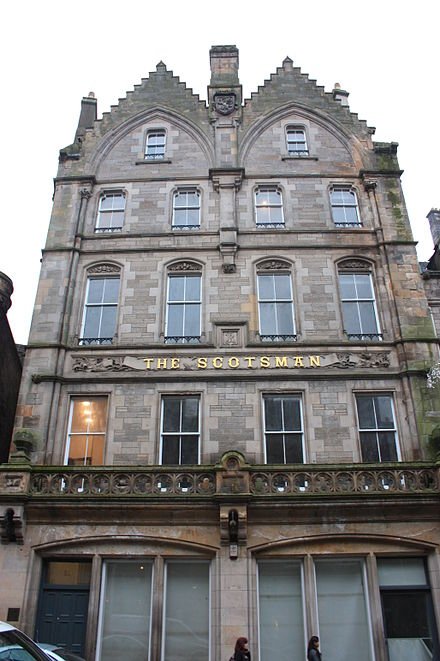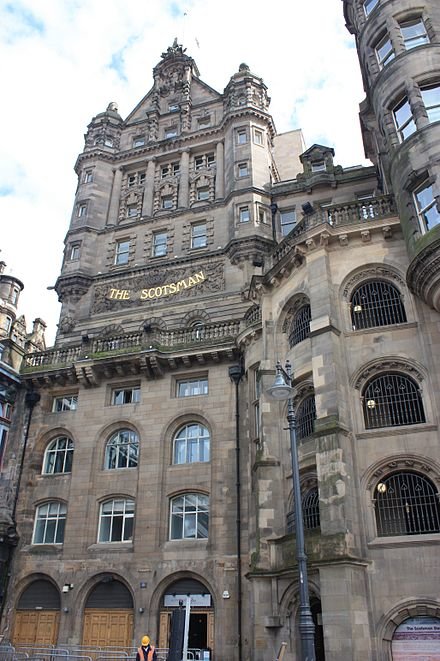British Heritage
Remember, Cherish, Learn.
beta
The Scotsman
A Pillar of British Heritage.
From its inception in the early 19th century, The Scotsman has been a stalwart of British journalism and a significant contributor to British heritage. Founded on the principles of impartiality and independence, it has consistently chronicled events that have shaped the United Kingdom and beyond. The Scotsman's rich legacy, combined with its ongoing commitment to innovative journalism, serves to uphold its esteemed position within the pantheon of British media.
Established in 1817, The Scotsman was the brainchild of lawyer William Ritchie and customs official Charles Maclaren. Their intent was to offer a radical alternative to existing newspapers of the time, which they viewed as being excessively subservient to the Edinburgh establishment. The duo pledged to uphold the tenets of "impartiality, firmness and independence," thereby ensuring that their publication offered an unvarnished perspective on the day's events.
The Scotsman initially commenced operation as a liberal weekly newspaper, but following the abolition of the newspaper stamp tax in Scotland in 1855, it transitioned into a daily publication. Despite a modest initial circulation of 6,000 copies, it was priced competitively at a single penny, making it accessible to a broad cross-section of the populace.
The first headquarters of The Scotsman was located at 257 High Street on the Royal Mile in Edinburgh. As the newspaper expanded, it relocated in 1860 to a bespoke office on Cockburn Street, designed in the Scots baronial style by the architectural firm Peddie & Kinnear. This location was conveniently adjacent to their original premises.
In 1904, the growing newspaper business moved once again to a grand building on North Bridge, complete with interconnected printworks on Market Street. This efficient setup allowed for direct below-road-level access to Waverley Station, facilitating seamless distribution.
In 1953, The Scotsman was purchased by Canadian millionaire Roy Thomson, marking the beginning of his media empire. The Barclay Brothers, David and Frederick, acquired the newspaper in 1995 for £85 million, moving its operations to the Holyrood Road. This modern office was in close proximity to the future location of the Scottish Parliament Building.
The Society for News Design (SND) acknowledged the newspaper's design prowess, naming it the World's Best Designed Newspaper™ in 1994. The Scotsman was subsequently acquired by Johnston Press in December 2005, a deal valued at £160 million.
The editorship of The Scotsman has seen several changes, with Ian Stewart assuming the position in 2012. Prior to this role, he was the editor of the Edinburgh Evening News and continues as the editor of Scotland on Sunday. Under Stewart's stewardship, The Scotsman was honoured as the Newspaper of the Year at the Scottish Press Awards in 2012.
Despite the changing landscape of print journalism, The Scotsman has shown resilience and adaptability. Following the sale of its Barclay House premises to Irish property magnate Lochlann Quinn in 2006, the publication moved to a refurbished premises at Orchard Brae House in Queensferry Road, Edinburgh. This strategic downsizing was said to save the company £1 million per annum in rent.
The Scotsman's editorial stance has also been instrumental in shaping political discourse in Scotland, including backing a 'No' vote in the referendum on Scottish independence.
In November 2018, Johnston Press filed for administration, marking a challenging period for the newspaper. However, it was quickly bought by JPIMedia, ensuring its continued operation. In 2020, the National World group, headed by former Daily Mirror executive David Montgomery, acquired JPIMedia, heralding a new era for The Scotsman.
The Scotsman's commitment to unbiased reporting, as well as its resilience in the face of shifting media landscapes, has seen it become a cherished part of British heritage. Over its 200-year history, it has grown from a radical weekly publication into one of Scotland's most widely read daily newspapers, with its digital platform, Scotsman.com, attracting an average of 138,000 unique visitors per day in 2017.
The Scotsman has not only been a conduit for news but has also contributed to significant conversations, political discourse, and societal shifts within the United Kingdom. As such, it stands as a testament to the indelible role of media in shaping and reflecting societal values and norms. Its continued operation and digitisation, as well as its strong readership, underscore its enduring relevance and contribution to the preservation of British heritage.
Early Years and Founding Principles
Established in 1817, The Scotsman was the brainchild of lawyer William Ritchie and customs official Charles Maclaren. Their intent was to offer a radical alternative to existing newspapers of the time, which they viewed as being excessively subservient to the Edinburgh establishment. The duo pledged to uphold the tenets of "impartiality, firmness and independence," thereby ensuring that their publication offered an unvarnished perspective on the day's events.
The Scotsman initially commenced operation as a liberal weekly newspaper, but following the abolition of the newspaper stamp tax in Scotland in 1855, it transitioned into a daily publication. Despite a modest initial circulation of 6,000 copies, it was priced competitively at a single penny, making it accessible to a broad cross-section of the populace.
Architectural Legacy and Expansion
The first headquarters of The Scotsman was located at 257 High Street on the Royal Mile in Edinburgh. As the newspaper expanded, it relocated in 1860 to a bespoke office on Cockburn Street, designed in the Scots baronial style by the architectural firm Peddie & Kinnear. This location was conveniently adjacent to their original premises.
In 1904, the growing newspaper business moved once again to a grand building on North Bridge, complete with interconnected printworks on Market Street. This efficient setup allowed for direct below-road-level access to Waverley Station, facilitating seamless distribution.
Ownership and Modern Developments
In 1953, The Scotsman was purchased by Canadian millionaire Roy Thomson, marking the beginning of his media empire. The Barclay Brothers, David and Frederick, acquired the newspaper in 1995 for £85 million, moving its operations to the Holyrood Road. This modern office was in close proximity to the future location of the Scottish Parliament Building.
The Society for News Design (SND) acknowledged the newspaper's design prowess, naming it the World's Best Designed Newspaper™ in 1994. The Scotsman was subsequently acquired by Johnston Press in December 2005, a deal valued at £160 million.
The editorship of The Scotsman has seen several changes, with Ian Stewart assuming the position in 2012. Prior to this role, he was the editor of the Edinburgh Evening News and continues as the editor of Scotland on Sunday. Under Stewart's stewardship, The Scotsman was honoured as the Newspaper of the Year at the Scottish Press Awards in 2012.
Challenges and Triumphs
Despite the changing landscape of print journalism, The Scotsman has shown resilience and adaptability. Following the sale of its Barclay House premises to Irish property magnate Lochlann Quinn in 2006, the publication moved to a refurbished premises at Orchard Brae House in Queensferry Road, Edinburgh. This strategic downsizing was said to save the company £1 million per annum in rent.
The Scotsman's editorial stance has also been instrumental in shaping political discourse in Scotland, including backing a 'No' vote in the referendum on Scottish independence.
In November 2018, Johnston Press filed for administration, marking a challenging period for the newspaper. However, it was quickly bought by JPIMedia, ensuring its continued operation. In 2020, the National World group, headed by former Daily Mirror executive David Montgomery, acquired JPIMedia, heralding a new era for The Scotsman.
Contribution to British Heritage
The Scotsman's commitment to unbiased reporting, as well as its resilience in the face of shifting media landscapes, has seen it become a cherished part of British heritage. Over its 200-year history, it has grown from a radical weekly publication into one of Scotland's most widely read daily newspapers, with its digital platform, Scotsman.com, attracting an average of 138,000 unique visitors per day in 2017.
The Scotsman has not only been a conduit for news but has also contributed to significant conversations, political discourse, and societal shifts within the United Kingdom. As such, it stands as a testament to the indelible role of media in shaping and reflecting societal values and norms. Its continued operation and digitisation, as well as its strong readership, underscore its enduring relevance and contribution to the preservation of British heritage.
- The Scotsmanen.wikipedia.org
